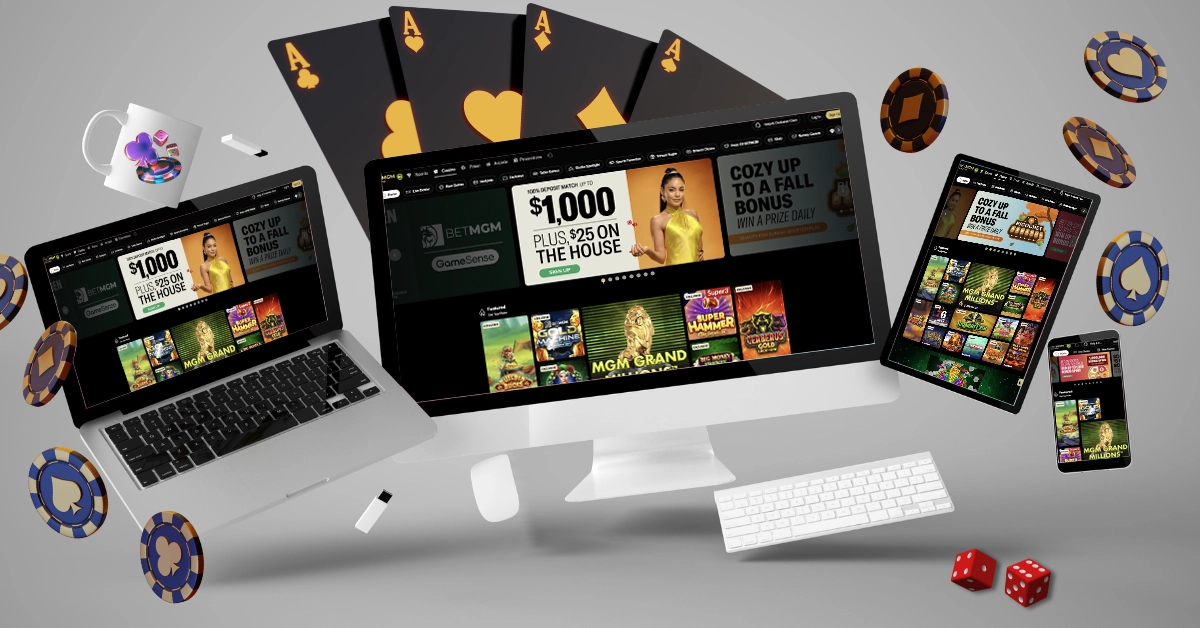The Influence of UX/UI Design in Making Online Casinos More Addictive

Gambling has gotten a serious upgrade in the last 10 years! It’s gone from the once smoke-filled physical casinos to our personal devices. You don’t have to do anything more than pick up your phone and log on to get your gambling fix—who would’ve imagined you’d be able to do that? But you can! And online casinos have changed gambling into a super accessible and visually appealing pastime. It has all of the colors of the rainbow, fun sounds, and seamless navigation. Gambling sites and apps draw players in, kind of like a virtual oasis of fun.
What might surprise you is just how much thought goes into the designs—online casinos aren’t only built to look pretty; they’re meticulously crafted to make gambling a continuous loop of endless possibilities. The user experience (UX) and user interface (UI) elements are anything but random—they are all carefully chosen to keep players playing. The point? To give users a nudge to make “just one more” bet.
We are gonna pull back the digital curtain to see exactly how the design choices impact player habits, influencing how people interact with online casinos and making it, frankly, addictive. To the way the colors and sounds prey on our emotions to the super subtle prods that encourage players to stay, let’s find out how what appear to be simple choices are actually keeping players coming again and again!
Understanding UX/UI in Online Casinos
Online casino apps have taken gambling off of the casino floor and right to our screens, and design has a major in how it keeps players engaged. Two big elements in this digital design are User Experience (UX) and User Interface (UI). The two concepts work in tandem to make a player’s time on the platform fun, and they each bring their own strengths with them.
User Experience, or UX, revolves around how a player interacts with a gambling site or app. In online casinos, UX design is used to make things easy to navigate so players can find games, understand the layout, and manage their accounts easily. The goal is intuitive navigation, quick load times, and clear instructions—platforms want to make a player’s journey through the platform feel effortless and enjoyable.
User Interface, or UI, is the visual side of an online casino experience. It’s what players see and interact with directly—the buttons, icons, colors, animations, and sounds that make the site or app come to life. UI design is optimally an inviting look and feel that holds a player’s attention and makes all interactions seamless. In online casinos, UI isn’t just about appearances; it’s made to keep players engaged with a visually appealing setup that’s simple to use.
In an online casino, UX and UI go hand in glove! UX keeps the platform simple to navigate so that nothing interrupts the player’s flow, while UI brings the excitement factor via visuals and sounds that grab attention. Together, they create an environment that means players come back with a setup that’s not only easy to use but also fun to explore!
Main UX/UI Elements That Improve Player Engagement
Online casinos have absolutely redefined gambling, taking the traditional casino experience and reworking it for the screen, all while keeping it accessible, engaging, and visually inviting. But what really hooks people? Behind the games and graphics are intentional design choices that make the experience both enjoyable and hard to leave. Below are the main UX/UI elements that all contribute to making that engaging environment!
Visual Design
A really central part of an online casino’s appeal is visual, and designers rely on stimulating colors, dynamic animations, and enticing graphics to create an atmosphere that feels both exciting and welcoming. Colors like red and green aren’t just chosen randomly—they’re actually rooted in color psychology, which shows how specific shades can influence emotions and decisions. Red, for example, is proven to evoke energy and excitement, and green is seen as a positive hue.

Animations add another element in terms of making games feel lively. Spinning reels, flashing icons, and subtle movements draw the eye, so the screen is active and engaging. Every tiny detail, down to a glowing button or a moving icon, is thoughtfully designed to hold a player’s attention. By tapping into color and motion, visual design creates a space that’s not only attractive but also energizing.
Reward Feedback Loops
Every single win, bonus, or spin comes with sounds and animations that make for a quick, satisfying “wheeeee!” And this feedback system isn’t just for decorative purposes; it triggers a feeling of reward by tapping into the brain’s natural reward cycle and releasing a hit of dopamine with each “win.” Moments of gratification build up, and that reinforces a player’s connection to the game.
The feedback loop doesn’t rely solely on big wins to make gameplay exciting—the smaller victories also play into it. All of the little celebrations keep players connected to the experience, building a steady rhythm that makes ordinary, non-winning spins seem like an accomplishment. Eventually, even little hits of excitement make gameplay more fun and fulfilling, and that encourages players to continue exploring.
Straightforward Navigation and Accessibility
Online casinos know some things and one of them is that a confusing layout or hard-to-navigate site will turn players off—and away from the platform. That’s why simplicity is so important. When there are well-organized menus, clear icons, and intuitive categories, it makes it easy for players to find their way around. It doesn’t matter if they’re looking for a specific game or just browsing—a good online gambling site knows this.
Navigation tools like filters, search bars, and favorites lists make it even easier to find exactly what users want. A straightforward platform guarantees that players will spend more time enjoying the games and less time trying to wrap their heads around how to use the platform.
As mobile gaming continues to get bigger, the accessibility across different devices is absolutely necessary. The experience on a phone or tablet should feel just as smooth as it does on a desktop. A responsive design lets players switch between devices, taking their favorite games with them without any snafus or interruptions. And flexibility means players can play anytime, wherever they happen to be, without any loss in quality!
Personalization Features
A personalized experience goes far in making players feel appreciated, and online casinos will remember previous game choices, suggest new ones based on playing habits, and hand out loyalty rewards like candy on Halloween. Profiles, loyalty programs, and tailored game recommendations build up a sense of familiarity and can make each player’s experience feel like it was made for them.
For example, most casinos have loyalty systems where players can earn points or rewards based on their activity. Logging in to see a set of game suggestions that match a player’s preferences or a reward that recognizes their playtime adds to the feeling of connection. Personalization can turn what could be a generic site into a much more engaging and customized space.
Loading Speed and Performance
There are very ew things that are as disruptive to gameplay as a dreaded lag or slow-ish load times, especially in high-energy games. Online casinos focus on delivering the fastest load speeds and smooth animations to avoid these issues. By optimizing performance, casinos provide an experience that is polished and uninterrupted.
Players benefit from a responsive platform that keeps up with them so that their focus remains on the game in front of them instead of being interrupted by technical glitches. Platforms are fine-tuned to run well across a range of different devices and internet speeds, so that players will have a reliable, high-quality experience.
Psychological Tricks in UX/UI Design to Increase Play Time
Online casinos are way past just offering players games—they’re crafting an entire experience that is specifically designed to keep players playing. With clever design elements that leverage human psychology, the platforms can draw out playtime, reeling players in and getting them to stick around for longer. How do they do it? With features like infinite scrolling, progress bars, and gamification—all of which exist to gently nudge players to stay logged in for longer periods of time.
Infinite Scrolling and Endless Games
Infinite scrolling is a super common design feature, nowhere more than on social media platforms, where the content continues to load as you scroll, so you never quite reach the “end.” The concept, which can be really addictive, has obviously found its way into gambling sites. It shows up in the form of an extensive and seemingly never-ending library of games, with new options being just one click away. There’s always another game to try, and players usually find themselves checking out the selection for way longer than they might have planned.

The approach taps into what’s known as the Zeigarnik effect—a phenomenon where people tend to remember unfinished tasks better than finished ones. When a player has so many options, there’s a lingering sense that they haven’t tried everything, and that makes them curious, so they come back to look again. In a way, the abundance of choices makes the platform feel like it’s always full of new things to uncover, and this can be a big motivator for players to stay logged in.
Another subtle aspect of infinite options is the low commitment. Players can hop from game to game without pausing, moving through options with the same fluidity they would if they were scrolling on social media. It’s effortless to keep trying new games, especially if the casino interface is designed with clear categories, suggestions, or a “for you” section that makes browsing seem like it was tailored to you.
Progress Bars and Leveling Up
Progress indicators, like bars, levels, or badges, are some of the most powerful motivators in UX/UI design. When players are able to see their advancement—via levels, points, or loyalty statuses—they’re given a concrete sense of progression, and that can be super engaging. Online casinos lean on this concept heavily in programs or achievement systems, and every completed level or milestone feels like a step toward a reward.
Psychologically, “leveling up” taps into our desire for growth and mastery. Seeing a progress bar fill up or unlocking a new status, gives players a little dopamine boost, much like achieving a goal in real life. This feeling of progression is highly satisfying and keeps players coming back to see how far they can go. It’s a subtle nudge that tells players, “You’re close—just a little more time, and you’ll get to that next level!”
For players, these progress indicators make the platform feel like more than just a series of games; it becomes a journey with milestones and achievements. Players might initially sign up to play a game or two but find themselves motivated to play longer, aiming for the next status level or reward. The platform will even add countdowns or reminders, highlighting how close players are to their next reward. This adds a sense of urgency, prompting them to spend more time reaching their goals.
Gamification
Gamification brings in game-like features—missions, tasks, badges, and rewards—that can add a whole new layer to the experience. Rather than just playing games, players are given challenges or “missions” that reward them for specific actions, like playing certain games, achieving a winning streak, or hitting milestones. This strategy keeps things fresh, adding little twists that give players more reasons to stay active on the platform.
Basically, gamification exploits our innate drive for accomplishment—completing tasks or earning rewards satisfies the basic human desire for achievement, so players have a sense of purpose along with the immediate thrill of gambling. The approach also creates a cycle where players feel like they’re working toward something, even if it’s only a virtual badge or a small bonus. By gamifying certain elements, online casinos make the experience feel more dynamic and goal-oriented.
Rewards are a huge part of gamification. For instance, players might earn virtual coins, bonus rounds, or loyalty points, which they can collect over time.
These rewards don’t just add an extra layer of enjoyment; they also serve as mini-achievements that keep players coming back. When players feel like they’re accumulating something, they’re more inclined to keep playing, building a sense of loyalty to the platform.
Some platforms take gamification even further–there are time-limited challenges or daily missions, and this builds a sense of urgency. If you know that a reward or task will expire soon, you’re going to spend extra time trying to get there, right? You don’t want to miss out on the opportunity to complete it, which is where the psychological FOMO (fear of missing out) comes into the equation, and it usually means players will engage more often and consistently.
Social Interaction Features and Their Role in Addictiveness
The modern casino landscape has turned gaming from solo play to one that’s full of social interactions. They’ve integrated features that let players chat, compete, and track their progress against others, thus making an environment that feels lively and connected. Let’s see how elements like in-game chat, multiplayer options, leaderboards, and tournaments contribute to an immersive—and, at times, addictive—gameplay.
In-Game Chat and Multiplayer Options
In-game chat and multiplayer functions introduce a social layer to online casino games that haven’t always been present. Players can now interact with others in real-time, sharing reactions, swapping tips, and celebrating wins together. The chat function allows players to feel part of a broader community, turning a solitary game into a shared experience.
The social features capitalize on another powerful aspect of human psychology: social reinforcement. When players share their wins or engage in conversations during gameplay, they get a sense of validation from others. This social reinforcement can enhance the enjoyment of each game, as players feel both individually successful and collectively connected. There’s also a bit of Fear of Missing Out (FOMO) at play. Knowing others are actively participating can encourage players to stay engaged so they don’t miss out on shared experiences or special moments within the community.
Multiplayer games add an extra layer of connection by enabling direct competition or collaboration with other players. Players can join tables together, team up, or compete head-to-head, adding to the excitement. The ability to play with or against friends or other online users makes each game feel more engaging, creating a social loop that brings players back again and again.
Leaderboards and Tournaments
Leaderboards and tournaments introduce an entirely different level of competition, transforming the casino experience from casual play into a race for the top. Leaderboards display where players rank compared to others, motivating them to improve their position. This simple element taps into the desire to achieve and excel, prompting players to keep going as they climb the ranks.
The competitive spirit fostered by leaderboards can lead players to push their limits, sometimes staying longer than they intended just to see their name higher on the list. For many, it’s not just about winning in a single game—it’s about achieving a spot in the top rankings, which brings a sense of accomplishment and recognition.
Tournaments build on this competitive energy by offering structured events with prizes and special rewards for top performers. These events, which are often time-limited, encourage players to participate more frequently to improve their chances of winning. The time limit on tournaments creates a sense of urgency, which can prompt players to play more intensively, revisiting the game throughout the day or week.

Tournaments add another layer to the gaming experience by giving players something to work toward. Competing for a spot at the top, particularly when prizes or prestige are involved, keeps players coming back and makes the overall gaming experience more dynamic.
The Ethics of UX/UI in Online Casinos
Online casinos have gotten scarily good at crafting designs that lure people in—every button, color, and animation is placed where it is with intention. But there’s a bigger question here—how far is too far? As all digital spaces use increasingly engaging design techniques, they also raise some ethical questions. At what point does encouraging play cross into promoting addiction? Below, we break down some of the more controversial design choices, look at transparency efforts, and examine how the industry is straddling the fine line between engagement and responsible gambling.
Questionable Design Choices
Some design choices in online casinos are obviously made to keep players immersed. For instance, the combination of colorful graphics, sound effects, and easy-to-navigate menus creates an experience that feels pretty much seamless. Features like endless scrolling through games, flashy animations after every win, and constant notifications can make it tempting to keep playing “just a little bit longer.”
This raises some ethical concerns—design choices such as these draw upon psychological triggers, and that encourages players to spend more time and money on the platform. In the design world, tactics that push users toward more screen time are sometimes called “dark patterns.” They’re not inherently bad, but when used in an environment like online gambling, they can exploit vulnerabilities. Designers face a dilemma—how to make an engaging platform without creating something that might be addictive.
Many argue that designers and casino operators should share responsibility for player well-being. While their goal is to create a fun and engaging experience, they also need to consider how certain design elements may impact users who are prone to gambling addiction. Striking this balance isn’t easy, especially in a competitive industry where engagement is key to business.
Transparency and User Awareness
One way online casinos can address these ethical concerns is through transparency. When players can clearly see information like account balances, time spent playing, and betting histories, they’re more equipped to make informed choices. Features like balance trackers and session timers can give players a sense of control, making it easier to recognize when it might be time to take a break.
Adding in “reality checks”—alerts that pop up to remind players of their playtime or betting habits—can further promote self-awareness. These gentle nudges remind users of their activity and can encourage reflection.
For example, a simple notification saying, “You’ve been playing for an hour,” can prompt players to take stock of their time and spending.
Giving players tools to set limits is another step toward responsible design. Self-exclusion options, deposit limits, and bet caps are features that let players define their boundaries. When easily accessible, these tools empower users to make mindful choices. Transparency, when woven into the UI, gives players the information they need to stay in control of their gambling habits without feeling pressured.
Industry Regulations
In recent years, regulatory bodies have begun to take a closer look at how UX/UI design in online casinos affects player behavior. Some regions have introduced guidelines requiring casinos to implement responsible gambling features. For instance, the UK Gambling Commission mandates that online casinos include tools like time limits, financial limits, and reality checks, so players have options to manage their gameplay responsibly.
Some online casinos have responded by adding self-exclusion features, allowing players to block themselves from accessing their accounts if they feel their gambling is getting out of hand. Deposit limits are another option, letting players set the maximum amount they can spend in a certain period. These moves reflect a shift toward a more responsible gaming environment.
However, there’s still a lot of debate over how far regulations should go. Some argue that casinos should do more to help players manage their gambling habits, while others believe that too many restrictions could hinder the user experience. Finding a middle ground that balances player safety with an enjoyable gaming experience remains a challenge for the industry as a whole.
How Users Can Recognize and Manage Addictive UX/UI Designs
Online casino platforms are designed with features that are meant to engross players, but it’s helpful to be able to recognize the design choices that make gameplay feel more intense or harder to walk away from. By understanding common UX/UI elements that are made to amplify engagement and knowing the ways you can manage your playtime, you will be able to have fun and be mindful of your gaming habits!
Awareness of UX/UI Triggers
Online casinos usually use subtle design techniques to make the experience feel seamless and immersive. Visual and auditory cues, for instance, are particularly effective. Bright flashing lights after a win or the constant appearance of buttons that encourage more play can reinforce the desire to continue. Sound effects, like celebratory jingles that play with each spin or win, create small bursts of reward, making actions feel more satisfying and giving the impression of “mini-victories.”
Notifications and time-sensitive prompts can also play a role. Pop-ups reminding users of bonuses about to expire or highlighting limited-time events can create a sense of urgency, making it harder to pause. Recognizing these patterns and understanding how they affect your own play habits can help you make more mindful choices.
Tips for Managing Play Time
Once you’re aware of what tends to engage you more intensely, setting clear boundaries can help.
- One approach is to create personal time or spending limits before even logging in. This might mean deciding in advance how much time you want to spend or setting a budget that you’ll stick to no matter what. Knowing your boundaries upfront can make it easier to stop once you reach them.
- Using time-tracking apps or built-in reminders is also useful for staying mindful of how long you’ve been playing. Some online casino platforms include session timers or reality checks that pop up after a certain period, encouraging players to take breaks and assess their time spent. When available, these tools can be beneficial for staying in control.
- Another option is to opt for games that offer a slower pace or don’t rely as heavily on stimulating visuals and sounds. Games that feel more relaxed or have natural stopping points can make it simpler to pause when you’re ready. Exploring games that align more with a calm experience can help maintain a sense of balance during play.
Resources for Help
For those who are finding it hard to maintain limits on time or spending, there are so many helpful resources dedicated to supporting responsible gambling! Most countries have helplines and websites focused on providing guidance and assistance for anyone who might be struggling.
For example, the National Problem Gambling Helpline in the U.S. (1-800-522-4700) and BeGambleAware in the U.K. (0808 8020 133) offer confidential support.
Some online casinos also collaborate with organizations that support responsible gaming practices, and these sites often offer information on self-exclusion programs. These tools give players a way to temporarily block themselves from accessing their accounts, providing a practical option for anyone who feels they need a break.
Support groups, both online and in-person, can also be valuable resources. Programs like Gamblers Anonymous create spaces where individuals can connect with others facing similar challenges. These groups often provide resources, meetings, and online forums where players can find guidance and community support.
Conclusion
Alrighty, let’s put a pin in this for now. We covered a lot of ground about how online casinos use cool designs so that things stay interesting—and, in doing so, make it harder to stop playing!
Here’s a quick rundown of what’s going on behind your device screen:
- Flashing Lights and Fun Sounds: The celebratory sounds and colorful graphics aren’t just for show—they exist so that every spin feels like a win.
- Infinite Games and Scrolling: With endless games and seamless scrolling, there’s always “just one more” to try.
- Levels, Points, and Progress Bars: Small achievements, badges, and progress bars give us that adrenaline rush, which prods you to keep on going.
- Social Features and Leaderboards: Chats, tournaments, and rankings give players a sense of community—and some competition that can be super hard to resist.
Final Thoughts
Here’s the plain truth: knowing what the design tricks are doesn’t mean that you can’t still play them and have fun! If anything, it puts you in control. When you are clued into what’s happening, you’re able to keep it fun and not let it rule over your gaming habits.
The next time you log in, keep an eye out for the tactics we went over. Set boundaries that work for you and play on your own terms. Online casinos are meant to be entertaining, and awareness will help you enjoy them without feeling like they’re the ones running the show.

Alyssa contributes sportsbook/online casino reviews, but she also stays on top of any industry news, precisely that of the sports betting market. She’s been an avid sports bettor for many years and has experienced success in growing her bankroll by striking when the iron was hot. In particular, she loves betting on football and basketball at the professional and college levels.








